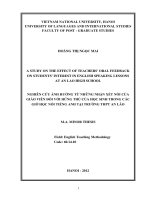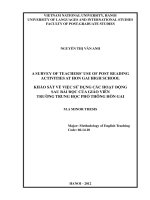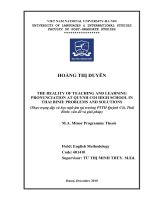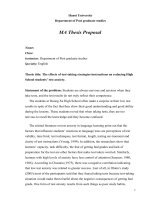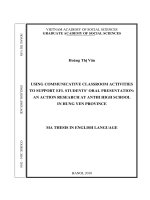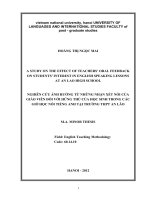Efl students’ employment of selfregulated learning strategies at han thuyen high school
Bạn đang xem bản rút gọn của tài liệu. Xem và tải ngay bản đầy đủ của tài liệu tại đây (1.01 MB, 130 trang )
MINISTRY OF EDUCATION AND TRAINING
HO CHI MINH CITY UNIVERSITY OF TECHNOLOGY
---------------
TA THI HONG LUA
EFL STUDENTS’ EMPLOYMENT OF SELFREGULATED LEARNING STRATEGIES AT HAN
THUYEN HIGH SCHOOL
Major: English Language
Course code: 8220201
HO CHI MINH CITY, 04/2022
MINISTRY OF EDUCATION AND TRAINING
HO CHI MINH CITY UNIVERSITY OF TECHNOLOGY
---------------
EFL STUDENTS’ EMPLOYMENT OF SELFREGULATED LEARNING STRATEGIES AT HAN
THUYEN HIGH SCHOOL
Submitted to the Faculty of English Language
in partial fulfillment of the Master’s degree in English Language
(Total number of words: 16836 words)
Course code: 8220201
By
TA THI HONG LUA
Supervised by
DUONG MY THAM, Ph.D.
HO CHI MINH CITY, 04/2022
ii
The thesis entitle EFL students’ employment of self-regulated learning strategies at
Han Thuyen High School was successfully defended and approved on July 11, 2022,
at Hochiminh City University of Technology (HUTECH).
Academic supervisor: Dương Mỹ Thẩm, Ph.D.
Examination Committee
1. Nguyen Thi Kieu Thu, Ph.D.
Chair
2. Le Van Tuyen, Ph.D.
Reader 1
3. Le Thi Thuy Nhung, Ph.D.
Reader 2
4. Nguyen Thi Thu, Ph.D.
Member
5. Tran Quoc Thao, Ph.D.
Secretary Member
On behalf of the Examination Committee Chair
(full name, title, signature)
iii
HCMC UNIVERSITY OF TECHNOLOGY
POSTGRADUATE INSTITUTE
HCMC, April 2022
MASTER’S THESIS REPORT
Student name: TẠ THỊ HỒNG LỤA
Sex: Female
Date of birth: 04 Nov 1990
Place of birth: Binh Định
Major: English Language
Student code: 2041900008
I- Thesis title:
EFL students’ employment of self-regulated learning strategies at Han Thuyen
High School
II- Objectives and contents:
The objectives of this research study are to explore the extent to which the 12th graders
at Han Thuyen high school use self-regulated learning strategies and find out if the
students encounter any difficulties in employing self-regulated learning strategies.
The contents of the study are presented following the literature review of self-regulated
learning strategies and difficulties that students encounter when they employ selfregulated learning strategies in onsite learning. Research methodology, results of the
study and the conclusion of the study are also the main points in the content of study.
Basing on the results of the study, the implications for teachers, students and school
managers about the importance of self-regulated learning strategies are given.
III- Starting date: 20 Sep 2021
IV- Completing date: April 2022
V- Academic supervisor: Duong My Tham, Ph.D.
ACADEMIC SUPERVISOR
FACULTY DEAN
(Full name, signature)
(Full name, signature)
iv
CERTIFICATE OF ORIGINALITY
I certify my authorship of the Master’s Thesis submitted today entitled:
EFL STUDENTS’ EMPLOYMENT OF SELF-REGULATED LEARNING
STRATEGIES AT HAN THUYEN HIGH SCHOOL
In terms of the statement of requirements for Theses in Master’s programs issued by
the Higher Degree Committee of Faculty of English Language, Ho Chi Minh City
University of Technology.
Ho Chi Minh, April 2022
TA THI HONG LUA
v
RETENTION AND USE OF THE THESIS
I hereby state that I, TA THI HONG LUA, being a candidate for the degree of Master
of Arts (English Language) accept the requirements of the University relating to the
retention and use of Master’s Theses deposited in the Library.
In terms of these conditions, I agree that the original of my Master’s Thesis deposited
in the Library should be accessible for purposes of study and research, in accordance
with the normal conditions established by the Librarian for the care, loan, and
reproduction for theses.
Ho Chi Minh, April 2022
Signature:
TA THI HONG LUA
vi
ACKNOWLEDGEMENTS
I would like to give my deepest and warmest gratitude to my supervisor, Dr. Duong
My Tham who gave valuable guidance and advice for supporting me to complete my
thesis. Her knowledge, vision, and sincerity have motivated me. I could not complete
my research without her encouragement. She has taught me the research methodology
as well as corrected my mistakes in the study with her great patience and sympathy. I
am extremely grateful for what she had done for me.
I would like to express my gratitude to The Institute of Postgraduate Studies of HCMC
University of Technology (HUTECH) for giving me the opportunity to do this
research. I would like to show my thankfulness to all teachers at the Faculty of English
language, especially I would like to extend my heartfelt thanks to Dr. Nguyen Thi Kieu
Thu because of their enthusiastically teaching and support during my learning course.
I would like to show my warmest thanks to my classmate, Ms. Mai Thi Tuyet Nga for
helping during my process of collecting research data and giving me sincerely advice.
Also, I express my thanks to all my friends in Class 20SNA11 for creating the friendly
studying environment that made me conveniently finish my assignments.
I am very much thankful to my family (my father, mother, sister, brother, especially
my husband and daughter for assisting me during my learning course. Their love,
caring and understanding have inspired me in my educating process. They are always
by my side. Without my family, I would not have finished this thesis.
vii
ABSTRACT
Learning English is necessary for global communication so finding effective learning
strategies to promote English skills is very important for students. Self-regulated
learning strategies (SRLS) is not a strange term referring to learning processes in which
students conducts various learning activities independently and purposely such as
setting goals, planning, self-motivating, self-monitoring, using flexibly learning
strategies, seeking help, controlling attention and self-evaluating. This study aims to
explore the extent to which the 90 twelfth graders at Han Thuyen high school used selfregulated learning strategies in English language learning and determine whether or not
they encountered any difficulties during their SRLS employment. The quantitative data
collected from the questionnaire were analyzed by SPSS (version 26) and the
qualitative data gathered from the semi-structured interviews were measured by using
content analysis. The results of the study revealed that all of the surveyed students
frequently employed SRLS for English learning, and most of the students agreed that
there were some difficulties during their SRLS employment. More interestingly, the
finding of the study also showed that there were two main kinds of difficulties
consisting of lack of regulation and external agents antiregulation of learning including
studying environment, family-related factors, friend-related factors, health problem and
unexpected events. Based on the finding of the present study, the pedagogical
implications were given for teachers, students and school managers to help students
gain the understanding of SRLS and how to make use of SRLS effectively. It is hoped
that these results of study as well as some recommendations for further studies may
practically and theoretically contribute to the research site as well as the field of EFL
education. (269 words)
Keywords: EFL learning, high school students, self-regulated learning, self-regulated
learning strategies
viii
TABLE OF CONTENTS
MASTER’S THESIS REPORT ............................................................................................................ iv
CERTIFICATE OF ORIGINALITY .................................................................................................... v
RETENTION AND USE OF THE THESIS ........................................................................................ vi
ACKNOWLEDGEMENTS.................................................................................................................. vii
ABSTRACT .......................................................................................................................................... viii
TABLE OF CONTENTS....................................................................................................................... ix
LIST OF ABBREVIATIONS.............................................................................................................. xiii
LIST OF TABLES ............................................................................................................................... xiv
LIST OF FIGURES .............................................................................................................................. xv
CHAPTER 1 ............................................................................................................................................1
INTRODUCTION ...................................................................................................................................1
1.1 Background to the study...............................................................................................................1
1.2 Statement of the problem .............................................................................................................2
1.3 Aims and objectives of the study..................................................................................................3
1.4 Research questions ........................................................................................................................4
1.5 Scope of the study ..........................................................................................................................4
1.6 Significance of the study ...............................................................................................................5
1.7 Definition of the key terms ...........................................................................................................5
1.8 Organization of the thesis .............................................................................................................6
CHAPTER 2 ............................................................................................................................................7
LITERATURE REVIEW.......................................................................................................................7
2.1 The concept of onsite learning .....................................................................................................7
2.2 Self-regulated learning..................................................................................................................7
2.3 Self-regulated learning strategies ............................................................................................. 11
2.3.1 Definition of self-regulated learning strategies ................................................................. 11
2.3.2 Categorization of self-regulated learning strategies......................................................... 14
2.3.2.1 Goal setting ....................................................................................................................... 14
2.3.2.2 Planning ............................................................................................................................ 14
2.3.2.3 Self-motivation.................................................................................................................. 15
ix
2.3.2.4 Attention control .............................................................................................................. 15
2.3.2.5 Flexible use of learning strategies ................................................................................... 15
2.3.2.6 Self-monitoring ................................................................................................................. 16
2.3.2.7 Help seeking ...................................................................................................................... 16
2.3.2.8 Self-evaluation .................................................................................................................. 17
2.4 Difficulties students encounter when they employ SRLS ....................................................... 17
2.4.1 Lack of regulation ............................................................................................................... 18
2.4.2 External agents antiregulation of learning ....................................................................... 20
2.5 Previous studies .......................................................................................................................... 20
2.6 Conceptual framework .............................................................................................................. 23
CHAPTER 3 ......................................................................................................................................... 27
METHODOLOGY............................................................................................................................... 27
3.1 Research design .......................................................................................................................... 27
3.2 Research site ............................................................................................................................... 27
3.3 Sample and sampling procedures ............................................................................................. 28
3.4 Research instruments................................................................................................................. 30
3.4.1 Students’ questionnaire ...................................................................................................... 31
3.4.2 Semi-structured students’ interview.................................................................................. 33
3.5 Data collection procedures ........................................................................................................ 33
3.6 Data analysis procedures ........................................................................................................... 35
3.7 Validity and Reliability .............................................................................................................. 37
3.7.1 The report of pilot questionnaire ....................................................................................... 38
3.7.2 The report of pilot interview .............................................................................................. 40
3.7.3 Reliability of survey ............................................................................................................ 40
3.8 Ethical issues............................................................................................................................... 41
3.9 Summary ..................................................................................................................................... 42
CHAPTER 4 ......................................................................................................................................... 43
RESULTS AND DISCUSSIONS ........................................................................................................ 43
x
4.1 Results ......................................................................................................................................... 43
4.1.1 The employment of SRLS of participants in English language learning. ...................... 43
4.1.1.1 The employment of goal getting strategies ..................................................................... 44
4.1.1.2 The employment of planning strategies ......................................................................... 46
4.1.1.3 The employment of self-motivation strategies ............................................................... 47
4.1.1.4 The employment of attention control strategies ............................................................ 48
4.1.1.5 The employment of flexible use of learning strategies .................................................. 50
4.1.1.6 The employment of self-monitoring strategies .............................................................. 52
4.1.1.7 The employment of help seeking strategies.................................................................... 53
4.1.1.8 The employment of self-evaluation strategies ................................................................ 54
4.1.2 Difficulties that students encounter when they do SRLS ................................................ 56
4.1.2.1 Lack of regulation ............................................................................................................ 57
4.1.2.2 External agents antiregulation of learning .................................................................... 59
4.2 Discussion.................................................................................................................................... 61
4.2.1 The employment of SRLS ................................................................................................... 61
4.2.2 Difficulties that students encounter when doing SRLS ................................................... 62
4.3 Summary ..................................................................................................................................... 63
CHAPTER 5 ......................................................................................................................................... 64
CONCLUSION AND RECOMMENDATION ................................................................................. 64
5.1 Summary of the main findings of the thesis ............................................................................. 64
5.2 Pedagogical implications ........................................................................................................... 65
5.2.1 Teachers ............................................................................................................................... 65
5.2.2 Students ................................................................................................................................ 66
5.2.3 School managers .................................................................................................................. 67
5.3 Limitations .................................................................................................................................. 67
5.4 Recommendations for further research ................................................................................... 68
xi
REFERENCES ..................................................................................................................................... 68
APPENDIXES ...................................................................................................................................... 78
APPENDIX A- SYLLABUS OF ENGLISH 12 ............................................................................. 78
APPENDIX B – STUDENTS’ QUESTIONNAIRE (FINAL VERSION) ................................... 92
APPENDIX C– BẢNG HỎI DÀNH CHO HỌC SINH (BẢNG CHÍNH THỨC) ...................... 98
APPENDIX D – STUDENT’S INTERVIEW QUESTIONS ...................................................... 104
APPENDIX E – CÂU HỎI PHỎNG VẤN DÀNH CHO HỌC SINH ....................................... 105
APPENDIX F – RELIABILITY OF EIGHT CATEGORIES OF SRLS IN QUESTIONNAIRE
.......................................................................................................................................................... 106
APPENDIX G- RELIABILITY OF ITEMS OF DIFFICULTIES IN QUESTIONNAIRE ... 113
xii
LIST OF ABBREVIATIONS
SRL: Self-regulated learning
SRLS: Self-regulated learning strategies
EFL: English as a foreign language
M: Mean
SD: Standard Deviation
SPSS: Statistical Package for the Social Sciences
xiii
LIST OF TABLES
Table 3.1: Participants’ personal information
Table 3.2: The adaption of the students’ questionnaire
Table 3.3: Data analysis procedures
Table 3.4: The difference between questionnaire’s pilot version and final version
Table 3.5: Reliability of eight categories of SRLS in questionnaire
Table 4.1: The employment of SRLS of students in English language learning
Table 4.2: The frequency of using goal setting strategies
Table 4.3: The frequency of using planning strategies
Table 4.4: The frequency of using self-motivation strategies
Table 4.5: The frequency of using attention control strategies
Table 4.6: The frequency of flexible use of learning strategies
Table 4.7: The frequency of self-monitoring strategies
Table 4.8: The frequency of help seeking strategies
Table 4.9: The frequency of self-evaluation strategies
Table 4.10: The number of students answered whether they faced difficulties
Table 4.11: The agreement of difficulties
Table 4.12: The agreement of lack of regulation
Table 4.13: The agreement of external agents antiregulation of learning
xiv
LIST OF FIGURES
Figure 2.1: Phases and subprocesses of self-regulation
Figure 2.2: Conceptual framework
Figure 3.1: Data collection procedure
xv
CHAPTER 1
INTRODUCTION
1.1 Background to the study
English has become a popular language in globalization because learning English can
help people make a real connection by together understanding about different cultures
and lifestyles. Due to the important role of English, teaching and learning English are
carried out at all levels from kindergarten so that students can be proficient in
communication. Furthermore, students not only gain academic achievement but also
prove their ability for their future work. Among all levels, teaching and learning
English in high school is considered as an important milestone, students have to take
the annual exams and graduation exams for choosing their future career. Students
themselves have to be proactive in their learning process, therefore finding the way
how to study effectively as well as suitable studying strategies is concerned.
Gettinger and Seibert (2002) examined that student’s proficiency was associated with
their understanding and the employment of effective studying strategies. According to
Nicaise and Gettinger (1995), a good student in all classes also might encounter
difficulty, it was not because he or she did not have ability, due to their lack of good
study skills. Zimmerman (1990) highlighted the implications of self-regulated learning
strategies (SRLS) on student’s learning and achievement. Cognitive and behavioral
self-regulation was an important aspect of learning and the level of school students
becoming self-regulators of their own learning process affect their academic
performance (Zimmerman, 2008). DiBenedetto (2011) stated that one of the most
important components of self-regulated learning (SRL) was the concept of selfefficacy.
Effective self-regulating learners are proactive in goals setting, suitable strategies
determination, time planning, documents and information organizing and approach
changing, and tracking their learning by collecting feedback on their performance and
doing some appropriate adjustments for their learning in the future (Puustinen &
Pulkkinen, 2001). Self-regulated learners usually have self-generated thoughts, actions
and feeling to gain studying goals (Kellenberg, Schmidt, & Werner, 2017). In order to
reach learner’s academic achievement, employing the SRLS is very important. Tran
Quoc Thao & Nguyen Chau Hoang Long (2020) explored that the different students
have different SRLS to enhance their proficiency. Learning at school means attending
the class and listening to the teacher instructions is not enough for learner to get all
new information as well as knowledge in the textbook. In this sense, learners just spend
their time focusing on the lessons during class time; it is not sure that they can study
effectively. Rather, they spend more time outsides school time for preparing the
lessons and studying the information, i.e., learners use their valuable time for reflecting
and studying materials, it will make the positive effect for their learning. Besides, it is
vitally necessary to find out the employing SRLS of students and major difficulties
faced by students when they employ these strategies.
1.2 Statement of the problem
It is claimed that an e-learner’s scholastic performance was more influenced by the
learner’s SRLS than by other learning management system satisfaction (Lee, 2009).
According to Zimmerman (2001), these strategies play a vital role in enhancing
learner’s proficiency and were a way to distinguish the good and poor students. Tran
Quoc Thao and Duong My Tham (2013) stated that learners could reach more
academic achievement if they were able to self-regulate. Many students apply these
strategies in learning process to gain learning autonomy goals, however, they need to
improve their SRLS (Tran Quoc Thao et al, 2020). Due to SRLS influence, it is
necessary to encourage students to employ these strategies appropriately.
2
In the context of Vietnam, students have to take the annual exam to meet the standards
upgrade, especially students are in high school and notably are in grade 12. The
national high school exam is an important event for all the 12th graders because passing
this exam, 12th graders can graduate from high school and entrance the college.
Therefore, it is necessary for 12th graders make the efforts to learn and get the
knowledge in this level. In order to not miss any information in the textbook and
improve their proficiency as well as increase their learning proactiveness, employing
self-regulated learning strategies is very important. During their self-regulating
process, studying at school or at home, there are many difficulties or disadvantages that
disturb students, it is not easy for students to overcome those difficulties so exploring
those difficulties are also necessary.
Although there have been many educational studies on the effects of employing SRLS,
there is lack of studies on employing the SRLS to gain students learning goals of high
school EFL students in Vietnam, especially the 12th graders. In addition, it is necessary
to find out the difficulties that EFLstudents encounter in using SRLS. Hence, it is
critically vital to conduct research to investigate what extend high school EFL students
to employ SRLS and some difficulties they confront in doing these strategies.
1.3 Aims and objectives of the study
The aim of the study is to explore the employment of SRLS at Han Thuyen high school
in onsite learning. It aims at finding out the extent of using SRLS of the high school
students and possible difficulties that students have faced when they have employed
those strategies. To put it specifically, the objectives of this study are:
(1) To explore the extent to which the 12th graders at Han Thuyen high school use
self-regulated learning strategies in English language learning;
(2) To find out if the students encounter any difficulties in employing self-regulated
learning strategies.
3
1.4 Research questions
The study attempts to address the two following research questions:
1. To what extent do the 12th graders at Han Thuyen high school employ selfregulated learning strategies in English language learning?
2. Do the students encounter any difficulties in employing self-regulated learning
strategies? If so, what are they?
1.5 Scope of the study
There were many different categories of SRLS. This study focused on eight main
categories of SRLS including goal setting, planning, self-monitoring, self-motivation,
attention control, help seeking, flexible use of strategies, and self-evaluation. This
study was conducted at Han Thuyen high school in Tan Phu District. Han Thuyen
High school consisted of thirteen classes for each level from grade 10 to grade 12
(from age 15 to 18). The participants included 90 students of grade 12.
The employment of SRLS of 12th graders was conducted in onsite learning context. At
Han Thuyen high school, students spent four English periods for a week in which three
main periods to study following the content in the textbook and one for practicing
exercises. During their onsite learning at school, they have to join in two semester
exams at the end of semester 1 and semester 2 and an important exam for graduation at
the end of school year.
This was a quantitative study in which a closed-ended questionnaire and semistructured interviews were used as main methods to collect the data. Observation
would not apply because the employment of self- regulated strategies of students was
not only at school.
In particular time, they could utilize these strategies in many
places and regardless of time. Therefore, questionnaire and interview were more
appropriate for the collection of data in this context.
4
1.6 Significance of the study
The previous studies of many researchers (Zimmerman, 2000; Pintrich & Zusho, 2002;
Zumbrunn, Tadlock and Roberts, 2011) aimed to find out different fields of SRLS such
as the effects of SRLS on learner’s competency, the phases of SRLS, factors that
affected on SRLS. While SRLS are important and essential process to improve
learner’s learning efficiency (Tran Quoc Thao & Duong My Tham, 2013), exploring
the employment of SRLS of high school students and clarify whether there is any
difficulty of present study have both theorical and practical significance.
For theorical significance, this study contributes for research field of SRLS by
emphasizing existed knowledge and complementing more literature review in SRLS’
employment in the context of Vietnam. In particular, the use of SRLS in high schools
in general and grade 12th specifically.
For practical significance, the study may cultivate EFL students’ awareness of SRLS
and help students recognize the important role of SRLS in learning English language.
Then students can frame foundation and feedback on the employment of SRLS in
positive way in order to be proactive in employing SRLS. Moreover, finding out
difficulties that students encounter during their SLRS process assists students to
recognize their troubles and try to overcome the obstacles efficiently.
1.7 Definition of the key terms
EFL students refer to students whose first language is not English and learning English
as foreign language. In this study, EFL students are Han Thuyen High school’s
students.
Self-regulated learning is a process in which students can control their thoughts, their
behaviors and emotions so that it can be directional for their learning experiences
successfully (Zumbrunn, Tadlock and Roberts, 2011).
5
Self-regulated learning strategies are strategies in which the learners set learning goals
and try to manage, adjust and control their cognition, motivation and behavior based on
their learning goals and conditions actively and constructively (Pintrich, 2000). In this
study, those strategies are goal setting, planning, self-motivation, attention control,
flexible use of learning, self-monitoring, help seeking and self-evaluation.
1.8 Organization of the thesis
The present thesis includes five chapters. Chapter 1: Introduction- This chapter
introduces the background of the study, the reason for conducting this study, overview
of the aims and objectives of study on the employment SRLS of students. In addition, it
clarifies the scope of study and its significance. The last part is organization of the
thesis.
Chapter 2: Literature review- This chapter presents the theoretical background of
studies on research field of SRLS. There are SRL, SRLS and previous studies. The
conceptual framework is drawn based on the literature review and research direction.
Chapter 3: Research methodology- This chapter provides the detail information on
research method including “research design”, “research site”, “participants”, “sample
and sampling procedures”, “research instruments”, “data collection and analysis
procedures”. Besides, there are validity and reliability of the research and ethical
issues.
Chapter 4: Results and discussions- This chapter presents the results of the study
which based on the collected data from questionnaire and interview, the discussion of
the findings
Chapter 5: Conclusion- The last chapter shows the conclusion of the study as well as
giving pedagogical implications. The limitation and recommendations for further
research are also mentioned.
6
CHAPTER 2
LITERATURE REVIEW
2.1 The concept of onsite learning
According to Young, Hausler and Sanders (2008), onsite learning was traditional
learning way in which teachers had face to face contact with students at school.
Teachers is present in class and use the word of mouth as the mean of instruction. In
this way, teachers can get the messages relating to direct feedback to indicate students’
comprehension such as raising hands, using body language and facial expression.
There are opportunities for students to make the questions and get the answers
immediately. Moreover, it is convenient for students to make group work. Adarkwah
(2021) emphasized onsite learning classes only hosted the certain number of students at
the particular time as well as at one location.
The concept of onsite learning has been highlighted more often when the time of
appearance of online learning. Many researchers have conducted the study to make a
comparison between the benefit of onsite learning and online learning (Romeo &
Usart, 2014). In exploring the advantages of onsite learning, Barkley (2001) stated that
onsite learning generally was stronger at providing constructive and directive feedback
from teachers. In some cases, onsite learning was the necessary way to check student’s
academic performance skills to help teachers have authentic evaluation results.
2.2 Self-regulated learning
SRL has been the mainly topic in many studies (Boekarerts, Pintrich, & Zeidner, 2000;
Pintrich & Zusho, 2002; Tran Quoc Thao & Duong My Tham, 2013; Zimmerman,
1990; Zimmerman, 2008; Zimmerman & Schunk, 2011; Zumbrunn, Tadlock &
Roberts, 2011). There are many various concepts of SRL. Zimmerman (2008, p.166)
viewed SRL as “the self-directive processes and self-beliefs which enable learners to
transform their mental abilities, such as verbal aptitude, into an academic performance
7
skill, such as writing”. Self- direction means learners create their own decisions and do
the task in their way, rather than being directed by teachers, self- beliefs mean learners
have confidence in their ability. In these processes, learners are proactive in their
learning, for example in enhancing speaking skill or writing skill to acquire knowledge.
While Zumbrunn, Tadlock and Roberts (2011, p.4) defined SRL as “a process that
assists students in managing their thoughts, behaviors, and emotions in order to
successfully navigate their learning experiences”. It means that the process will happen
when students direct the purposeful actions toward the achievement of knowledge or
skills (Zumbrunn, Tadlock & Roberts, 2011). That is an approach in which leaners
control their mental thinking, actions, feelings initiated to achieve success in learning.
According to Pintrich & Zusho (2002), SRL is divided into four different phases:
planning and goal setting, monitoring processes, control and regulation processes, and
reactions and reflections. For the first phase, planning and goal setting is relating to
student’s perceptions and knowledge of the task and the context, the students analyze
the task, plan the time and effort, and set the target goal to do the task. For the second
phase, monitoring processes are presented by awareness and monitoring of effort, time
use and need for help. The next phase - control and regulation processes involves
efforts to manage and regulate various aspects of the task or context. Finally, the fourth
phase is associated with many different reactions and evaluation of the students on the
task or context. Pintrich and Zhusho (2002, p.251) also pointed out that “in most
models of self-regulated learning, monitoring, control, and reaction can be ongoing
simultaneously and dynamically as the individual progresses through the task, with
goals and plans being changed or updated based on the feedback from the monitoring,
control, and reaction processes.”
In some studies (Zimmerman & Campillo, 2003; Zumbrunn, Tadlock & Roberts 2011),
SRL includes three distinct phases: forethought planning, performance monitoring and
8
reflections on performance (Figure 2.1). Tran Quoc Thao and Duong My Tham (2013)
clarified that in the first phase, students do analysis of learning task and set the specific
target for doing the task. In case, students encounter with unfamiliar topics, it may not
be easy to find the best way to approach the task or what goal is the most suitable goal.
Teachers or instructors often instruct them how to approach effectively for the task in
that case. Then performance monitoring is the phase in which students do strategies to
control the effectiveness of those strategies combined with promoting their motivation
towards reaching the goals of the task. In this phase, students may face to learning the
new strategies, students may spend much time to understand and apply them for
meaningful learning. Therefore, they tend to revert to using the familiar and ineffective
strategies, it is necessary for teachers to monitor and give the feedback for students to
help them learning the new strategies effectively. In reflections on performance,
students do evaluation of their performance on their learning task relating to the
effectiveness of strategies they selected. Students should manage their feelings about
the results of learning experience, due to the influence of their self- reflection on their
future planning and goals to begin again the cycle of phase (Zumbrunn, Tadlock &
Roberts,2011).
9
Figure 2.2 Phases and subprocesses of self-regulation (B. J. Zimmerman & M.
Campillo, 2003)
Performance Phase
Self-control
Self-instruction
Imagery
Attention focusing
Task strategies
Self- Observation
Metacognitive monitoring
Self-recording
Forethought phase
Task analysis
Self-Reflection Phase
Goal setting
Self-Judgment
Strategic planning
Self-evaluation
Self- Motivation Beliefs
Causal attribution
Self-efficacy
Self- Reaction
Outcome expectations
Self- satisfaction/affect
Task interest/value
Adaptive/defensive
Goal orientation
10

